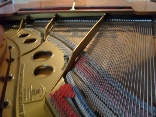


1
This is the version of the question WHICH DOES USE KEY SIGNATURES.

2
The first step is easy. Just write out each note-
Work out the key (scale) of the extract. Knowing your cycle of 5ths, a key signature
of 2 flats means either Bb major, or G minor. Although there are accidentals, and
one F#, the tune is centred around the Bb major chord at the beginning, and there
are more F naturals than sharps so the key is Bb major. A minor 3rd down from Bb
is G so the transposition will be written in G major. (Not G minor -
( If you had determined the original as G minor, the same reasoning would have lead
to the transposed key of E minor also with one sharp -



3
Because we have worked through key signature, accidentals are going to be needed only where accidentals were used in the original but it could be a different sort of accidental. In this case E natural accidentals become C# accidentals.


4
Double -
In this case Bb’s have become G’s and F’s have become D’s.
